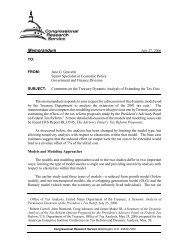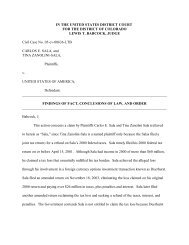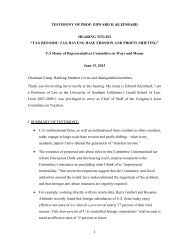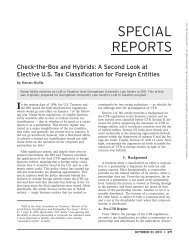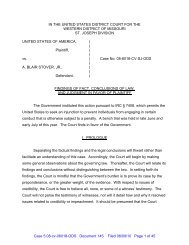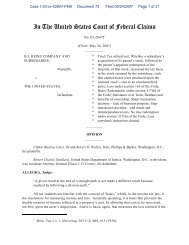Targeted Allocations Hit the Spot
Targeted Allocations Hit the Spot
Targeted Allocations Hit the Spot
Create successful ePaper yourself
Turn your PDF publications into a flip-book with our unique Google optimized e-Paper software.
COMMENTARY / SPECIAL REPORT<br />
This provision eliminates <strong>the</strong> need to adjust<br />
capital accounts in applying <strong>the</strong> alternate economic<br />
effect safe harbor for reasonably expected distributions.<br />
That leaves only <strong>the</strong> proverbial unwary who<br />
are subject to this adjustment.<br />
Recommendation 7: The IRS should consider<br />
mandating gross income allocations, absent a<br />
specific partnership agreement disclaimer to<br />
<strong>the</strong> contrary, to eliminate this trap for <strong>the</strong><br />
unwary.<br />
9. What happens if <strong>the</strong> partnership agreement<br />
does not provide for capital accounts or provides a<br />
faulty definition The section 704(b) regulations<br />
prescribe specific rules for maintaining capital accounts.<br />
When <strong>the</strong> partnership agreement is silent or<br />
provides a faulty definition, <strong>the</strong> regulations will still<br />
test <strong>the</strong> allocations based on a properly defined<br />
capital account.<br />
For partnerships that liquidate in accordance<br />
with capital accounts, <strong>the</strong> liquidation economics<br />
should as a matter of contract law be based on <strong>the</strong><br />
partnership definition of capital accounts, even if it<br />
departs from <strong>the</strong> tax law definition. This preserves<br />
<strong>the</strong> business deal but places <strong>the</strong> efficacy of <strong>the</strong> tax<br />
allocations at risk. This is <strong>the</strong> correct result. The IRS<br />
regulations should not be changed to provide a<br />
non-tax-compliant capital account definition for<br />
purposes of determining how partnership interests<br />
are to be liquidated.<br />
IV. <strong>Targeted</strong> <strong>Allocations</strong><br />
A. <strong>Targeted</strong> vs. Traditional <strong>Allocations</strong><br />
The typical partnership has partners who put up<br />
<strong>the</strong> cash; partners who contribute appreciated property,<br />
including zero basis intangibles; and partners<br />
who contribute nei<strong>the</strong>r but do <strong>the</strong> work. The money<br />
partners often want <strong>the</strong>ir money back first; those<br />
contributing goodwill and <strong>the</strong> like want to receive<br />
back <strong>the</strong> value someday but not necessarily upfront;<br />
and those contributing services will receive a profits<br />
interest. In <strong>the</strong> typical non-tax-driven business deal,<br />
<strong>the</strong> parties will reach agreement on <strong>the</strong> economics<br />
and perhaps provide for tax distributions, but will<br />
leave <strong>the</strong> tax allocations to <strong>the</strong> drafters of <strong>the</strong><br />
agreement.<br />
Under <strong>the</strong> traditional tax allocation approach, <strong>the</strong><br />
drafters will first put toge<strong>the</strong>r <strong>the</strong> cash flow priorities<br />
and will seek to build <strong>the</strong> profit and loss<br />
allocations around <strong>the</strong> cash flows. Final distributions<br />
will be made in accordance with capital accounts.<br />
Drafters who do not want to liquidate in<br />
accordance with capital accounts but who want<br />
more certainty than <strong>the</strong> dumb-but-lucky approach<br />
may use so-called targeted allocations. 31<br />
The typical partnership agreement containing<br />
targeted allocation provisions provides for detailed<br />
cash distribution provisions and says simply that<br />
profits and losses are allocated so that each partner’s<br />
capital account will be equal to (or as close as<br />
possible to) <strong>the</strong> cash he is supposed to receive under<br />
<strong>the</strong> cash distribution provisions if his partnership<br />
interest were liquidated at that time. This gives<br />
economic certainty and maybe tax certainty as well<br />
if <strong>the</strong> allocations are done properly, but it makes <strong>the</strong><br />
tax return preparer’s job more difficult.<br />
The classic situation in which a targeted allocation<br />
is used is when Partner A puts up <strong>the</strong> money<br />
and is entitled to a preferred return on <strong>the</strong> money<br />
plus a priority cash distribution of <strong>the</strong> preferred<br />
return and his capital.<br />
Example: Partner A contributes $1,000 to <strong>the</strong><br />
partnership. Partner B contributes goodwill<br />
worth $1,000. A is entitled to cash sufficient to<br />
provide A with a 10 percent preferred return<br />
plus capital; B <strong>the</strong>n receives an amount equal<br />
to his $1,000 capital contribution; and <strong>the</strong>n A<br />
and B split 50/50. Assume that in year 1 <strong>the</strong><br />
partnership has income of $400.<br />
The targeted allocation provision is a ra<strong>the</strong>r<br />
elegant way of providing A with capital back tax<br />
free. Under <strong>the</strong> targeted allocation approach, A and<br />
B’s capital account will be computed taking into<br />
account contributions and distributions for <strong>the</strong> year.<br />
Then <strong>the</strong> partnership will determine how much<br />
cash each partner would receive in liquidation.<br />
Based on <strong>the</strong> facts outlined above, <strong>the</strong> liquidation<br />
value (cash plus gross asset value of assets) was<br />
$2,400 ($1,000 original cash plus $1,000 goodwill<br />
plus $400 earnings); A is entitled to a $100 priority<br />
return after year 1 (10 percent preferred return) plus<br />
31 This approach has been called ‘‘forced allocations,’’ ‘‘target<br />
allocations,’’ and ‘‘targeted allocations.’’ We will use <strong>the</strong> term<br />
‘‘targeted allocations.’’ This topic has received relatively little<br />
attention in tax writings. Terence Floyd Cuff has been <strong>the</strong> most<br />
prolific writer on this topic. See Cuff, supra note 18. See also<br />
Terence Floyd Cuff, ‘‘Target <strong>Allocations</strong> and <strong>the</strong> Redemption of<br />
a Member,’’ 37 Real Estate Tax. 60 (2010); Todd D. Golub, ‘‘Target<br />
<strong>Allocations</strong>: The Swiss Army Knife of Drafting (Good for Most<br />
Situations — But Don’t Bet Your Life on It),’’ 87 Taxes 157 (2009);<br />
Thomas C. Lenz, ‘‘Using <strong>the</strong> <strong>Targeted</strong> Capital Account Approach<br />
to Allocate Income and Loss — Is It Better Than <strong>the</strong><br />
Traditional Layered Approach’’ 5 J. Passthrough Entities 25<br />
(2002); Brian J. O’Connor and Steven R. Schneider, ‘‘Capital<br />
Account Based Liquidations: Gone With <strong>the</strong> Wind or Here to<br />
Stay,’’ 102 J. Tax. 21 (2005); Warren P. Kean, ‘‘A Partner’s Interest<br />
in <strong>the</strong> Partnership for Purposes of Section 704(b),’’ 807 PLI 825<br />
(2008). A leading drafting treatise covers <strong>the</strong> topic tersely and<br />
treats ‘‘forced allocations’’ almost dismissively. Drafting treatise,<br />
supra note 27, at paras. 7-159 et seq.<br />
(C) Tax Analysts 2010. All rights reserved. Tax Analysts does not claim copyright in any public domain or third party content.<br />
102 TAX NOTES, October 4, 2010







